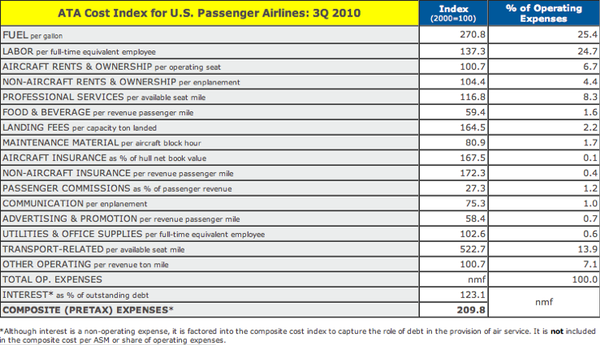US ATA chronicles rising costs which outpace inflation rate
Releasing its quarterly Airline Cost Index, the US Air Transport Association said the third quarter results continued a trend seen in previous quarters and puts increased pressure on airlines to find new ways to cut costs.
Costs faced by US passenger airlines, measured by the "composite cost index", rose 5% to 209.8 in the third quarter of 2010 compared with the same period of 2009, outpacing the 1.2% gain in the US Consumer Price Index (CPI), said ATA. The composite airline cost index remains approximately 110% higher than its level of 100 in 2000.
"The third-quarter results highlight the continued importance of offsetting the rising costs of doing business through operational efficiencies, productivity gains and diversification of revenue streams. Thanks to a strengthening economy and the continuing efforts of airlines to adapt to a volatile environment, the increase in costs did not stand in the way of profitability this quarter," said ATA Chief Economist John Heimlich. "Nonetheless, with costs likely to continue rising in this period of economic uncertainty, financial discipline remains paramount."
It certainly makes American's fight to reduce costs for online travel agents and global distribution systems more critical. American Chair Gerald Arpey said during the first half of 2010 that he wants to see OTAs and GDS pay the airline for being allowed to use its content making that the holy grail for the airline industry.
Fuel, labour and regional outsourcing costs account for the three largest components in the composite cost index and show fuel efficiency, labour productivity and revenue generation offset higher composite costs and pushed break-even load factor down 8.7 points to 75.9%. Those metrics were 7.3 points and 73.7% in 3Q2009. ATA also said the break-even load factor was the lowest since 1Q2001 and enabled the first consecutive quarters of profitability since the middle of 2007.
Despite the downward pressure on transportation-related expenses - monies paid to regional airline partners for capacity lift - such costs were up 13.9%.
It also recounted other findings:
- Combined fuel and labour costs accounted for half of airline operating expenses. The average price paid for fuel rose 10.6%, from USD1.92 to USD2.13 per gallon. The average cost (wages, benefits and payroll taxes) of a full-time equivalent worker rose 5.6% to a high of USD86,603.
Fuel costs as a percentage of operating expenses is a significant improvement over 2008 when fuel costs were approaching half of airline operating expenses. While that may be so, airlines cite rising fuel costs as their most worrying item.
Labour costs will continue to rise, something American is counting on as new contracts at Delta, US Airways and United begin to achieve parity with its higher labour costs.
- Other rising cost categories included, among others, advertising and promotion (up 12.8%), aircraft rents and ownership (up 9.4%), travel agency commissions (up 6.1%), landing fees (up 3.8%) and interest (up 3.6%).
- Other categories seeing year-over-year declines in input costs included maintenance material (cost of maintaining and purchasing materials for airframes, aircraft engines, ground property and equipment, down 6.7%), property rents and ownership (down 5.1%) and non-aircraft insurance (down 3.8%).
- Categories with changes of less than 3% were aircraft insurance, communication, food and beverage, professional services, transport-related expenses* and utilities and office supplies.
